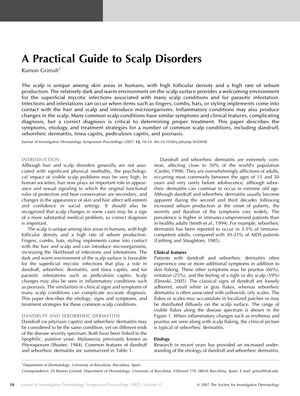TLDR The document concludes that proper diagnosis and treatment of common scalp disorders are important for both physical and psychological health.
The 2007 document reviews common scalp disorders, including dandruff, seborrheic dermatitis, tinea capitis, psoriasis, and pediculosis capitis, detailing their symptoms, causes, and treatments. It notes that nearly 50% of the population is affected by dandruff and seborrheic dermatitis, which are associated with the yeast Malassezia and treated with antifungal and other agents. Tinea capitis, prevalent in children, is treated with systemic antifungals and topical steroids. Psoriasis, affecting at least 2% of the population, is managed with topical and systemic therapies. Pediculosis capitis, common among school-aged children, is treated with insecticidal topicals and combing, plus environmental cleaning to prevent reinfestation. The document stresses the psychological impact of these conditions, the necessity of correct diagnosis, and the need for treatments that are effective and cosmetically acceptable. The author has received an honorarium from Procter & Gamble.
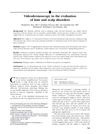 304 citations
,
July 2006 in “Journal of The American Academy of Dermatology”
304 citations
,
July 2006 in “Journal of The American Academy of Dermatology” Videodermoscopy improves diagnosis of hair and scalp disorders and may reduce scalp biopsies.
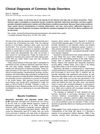 61 citations
,
October 2005 in “The journal of investigative dermatology. Symposium proceedings/The Journal of investigative dermatology symposium proceedings”
61 citations
,
October 2005 in “The journal of investigative dermatology. Symposium proceedings/The Journal of investigative dermatology symposium proceedings” The document concludes that accurate diagnosis is crucial for effectively treating common scalp disorders, which often have similar symptoms.
 61 citations
,
October 2005 in “The journal of investigative dermatology. Symposium proceedings/The Journal of investigative dermatology symposium proceedings”
61 citations
,
October 2005 in “The journal of investigative dermatology. Symposium proceedings/The Journal of investigative dermatology symposium proceedings” The document concludes that accurate diagnosis is crucial for effectively treating common scalp disorders, which often have similar symptoms.
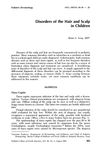 6 citations
,
August 1991 in “Pediatric Clinics of North America”
6 citations
,
August 1991 in “Pediatric Clinics of North America” The document concludes that various hair and scalp disorders in children have specific treatments and proper diagnosis is essential.
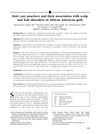 59 citations
,
August 2010 in “Journal of The American Academy of Dermatology”
59 citations
,
August 2010 in “Journal of The American Academy of Dermatology” Certain hairstyles and less hair oil use in African American girls can lead to scalp conditions like traction alopecia and seborrheic dermatitis.
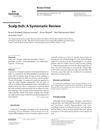 28 citations
,
November 2017 in “Skin appendage disorders”
28 citations
,
November 2017 in “Skin appendage disorders” The document concludes that accurate diagnosis and treatment of scalp itch require differentiating between various conditions using a proposed five-step evaluation process.
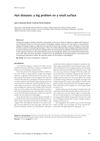 4 citations
,
January 2016 in “Postepy Dermatologii I Alergologii”
4 citations
,
January 2016 in “Postepy Dermatologii I Alergologii” Many hair diseases, including those caused by medications and psychological issues, can lead to hair loss and require proper treatment and specialist care.
